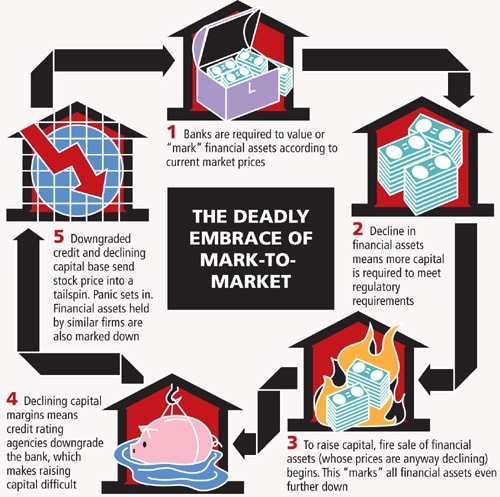Marked for Hell
Is it an early warning system or invitation to disaster? Mark-to-market accounting is tricky business


A man whom we shall call only A.K. runs an interesting business from India. He helps owners of large construction projects in Europe track progress with up-to-date analytical reports. He spends about $180,000 each month and gets a fixed sum of $300,000.
More than a year ago, when the rupee was strengthening and was heading towards 35 to a dollar, A.K. wanted to make sure he got at least Rs. 40 per earned dollar. So he bought a three-year forward contract. It was then that this successful businessman discovered such a thing as mark-to-market (MTM) accounting. Now, he is trying to prevent his company from being declared sick.
The dollar has since fallen to Rs. 50. His auditor wants A.K. to book a loss of Rs. 10 on every dollar that he will sell for the remaining 20 months of the forward contract. A.K. has gone hoarse saying that he gets his dollars from exports of services and doesn’t have to buy them at Rs. 50. But his auditors and his bank are helpless. They say his derivative contract is distinct from his income contract and that his derivative contract has to be marked to market. In which case, it will show that A.K. buys a dollar at Rs. 50 and sells it at Rs. 40! The total accounting loss is Rs. 6 crore, big enough to wipe out his net worth.
The only consolation for A.K. is that he is not alone in falling victim to the accounting monster called Mark-to-Market.
In India, MTM’s impact has been felt through foreign exchange derivatives and foreign currency debt. It is one of the most logical ways of accounting for assets owned by a company. “In earlier times, companies would carry a piece of land at Rs. 1 carrying cost, which would later be re-valued at much high prices thereby bolstering the balance sheet,” says Gautam Nayak, former president, Bombay Chartered Accountants Society.
In the “fair value” method used since the Great Depression, a company places its financial assets into one of three categories: held to maturity, available for sale and held for trading purposes. The last two categories are valued using a fair value. The first is valued at cost because it is not going to be sold or traded.
The best way to get a fair value is to check the price of that asset in the market or check for the price of a similar asset. For US banks it worked great because when markets were up, the complex securities they had purchased showed up as highly valuable. Indian companies benefited when they showed gains in foreign exchange derivative transaction because the rupee moved from Rs. 45 to Rs. 39 between 2006 and 2008. “When the going was good, no one had any problem,” says V. Balakrishnan, chief financial officer of Infosys Technologies.
All that was abandoned once the economic meltdown began and asset prices plunged. In the US, market participants clamoured to relax MTM rules. In India too, the Confederation of Indian Industry made a case for relaxing MTM rules. The responses have been diametrically opposite. The US Securities and Exchange Commission (SEC) analysed all bank implosions and found that MTM accounting was responsible for only 10 percent of banks’ capital loss. Over 90 percent of the loss was because of credit losses or because borrowers weren’t paying back loans. The SEC did not dilute MTM standards.
In India, the National Advisory Committee for Accounting Standards (NACAS) relaxed the guidelines for foreign exchange debt. Since dollar debt now costs more in rupees, Indian companies would have had to take this hit from the increase in the value of debt on their income statements. Image: Malay Karmakar
Image: Malay Karmakar
“The notification from NACAS is not as attractive as it seems, since it has a retrospective effect, which in many cases, would result in giving up exchange income earned in the previous year,” says Dolphy D’Souza, partner & national leader IFRS, Ernst & Young. Indian companies can now add the increase in the value of debt to the cost of plant machinery, which they may have bought using the forex debt, and depreciate it over the life of that plant or machinery. In the case of a long-term derivative contract, which has now gone wrong, the sins can be stashed away in a “foreign currency monetary item translation difference” account! There it will sit quarantined and not infect the income statement.
Opinion is divided on whether this was a good step. “There was an unprecedented move in dollar-rupee rates and it would [have] brought in a lot of volatility in earnings and so perhaps this step was needed,” says N. Mahalingam, CFO, Tata Consultancy Services. Balakrishnan of Infosys and Sanjeev Prasad of Kotak Securities feel such change in rules will only distort financial statements. For smaller companies, the relaxation may help but for many large corporations, like Wockhardt and Ranbaxy, it is an unnecessary reprieve. Many firms traded in forex markets like they were dealers. They should pay if their bets went wrong.
First Published: May 18, 2009, 17:45
Subscribe Now(This story appears in the Jun 19, 2009 issue of Forbes India. To visit our Archives, Click here.)